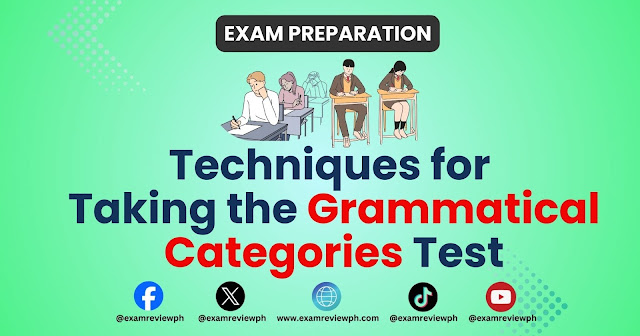Grammatical categories are features of words that define their syntactic roles and relationships within sentences. These categories include tense, aspect, mood, number, gender, case, and person. Tense (past, present, future) shows the time of an action (e.g., "walked," "walks"). Aspect (perfective, progressive) indicates the nature of the action (e.g., "has walked," "is walking"). Mood (indicative, imperative, subjunctive) expresses the speaker’s attitude (e.g., "She walks," "Walk!"). Number (singular, plural) differentiates one item from many (e.g., "cat," "cats"). Gender (masculine, feminine, neuter) assigns a category to nouns and pronouns (e.g., "he," "she"). Case (nominative, accusative) shows the word's function (e.g., "I" vs. "me"). Person (first, second, third) indicates the subject's perspective (e.g., "I," "you," "he").
Technique for Taking a Grammatical Categories Test
1. Understand Definitions:
- Tense: Identify the time an action occurs (e.g., "He studies" [present], "He studied" [past]).
- Aspect: Look for completion or continuation of actions (e.g., "She is studying" [progressive], "She has studied" [perfective]).
- Mood: Recognize the speaker's attitude (e.g., "She can go" [indicative], "Go!" [imperative], "If she were here" [subjunctive]).
- Number: Differentiate between one or more items (e.g., "child" [singular], "children" [plural]).
- Gender: Identify the noun or pronoun's gender (e.g., "actor" [masculine], "actress" [feminine]).
- Case: Determine the word’s syntactic function (e.g., "She" [nominative], "her" [accusative]).
- Person: Point out the subject’s perspective (e.g., "I" [first person], "you" [second person], "he" [third person]).
2. Analyze Sentence Structure:
- Identify the subject, verb, and object to determine the roles and relationships of words.
- Use contextual clues to understand how grammatical categories affect meaning.
3. Practice Regularly:
- Engage in exercises that focus on different grammatical categories.
- Review errors to grasp why a particular category is used in a specific context.

